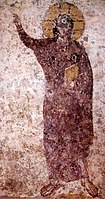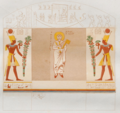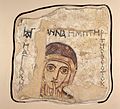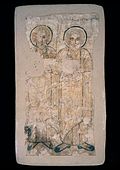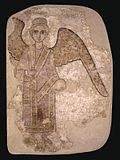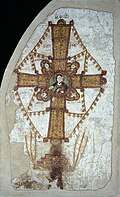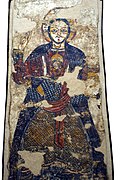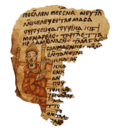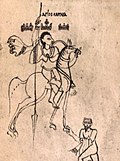Makuria
Kingdom of Makuria[1] | |||||||||||||
|---|---|---|---|---|---|---|---|---|---|---|---|---|---|
| 5th century–1518 Late 15th/16th century | |||||||||||||
|
The flag of Makuria according to theBook of Knowledge of All Kingdoms.c. 1350 | |||||||||||||
 The Kingdom of Makuria at its maximum territorial extent around 960, after a raid that reached as far north asAkhmim | |||||||||||||
| Capital | Dongola(until 1365) Gebel Adda(from 1365) | ||||||||||||
| Common languages | Nubian Coptic Greek Arabic[2] | ||||||||||||
| Religion |
| ||||||||||||
| Government | Monarchy | ||||||||||||
| King | |||||||||||||
•fl.651–652 | Qalidurut(first known king) | ||||||||||||
•fl.1463–1484 | Joel(last known king) | ||||||||||||
•c. 1520–1526 | Queen Gaua (new last known ruler) | ||||||||||||
| History | |||||||||||||
• Established | 5th century | ||||||||||||
• Royal court fled toGebel Adda,Dongola abandoned | 1365 | ||||||||||||
• Disestablished | 1518 | ||||||||||||
| Currency | Gold
Solidus Dircham | ||||||||||||
| |||||||||||||
| Today part of | Sudan Egypt | ||||||||||||
Makuria(Old Nubian:ⲇⲱⲧⲁⲩⲟ,Dotawo;Greek:Μακουρία,romanized:Makouria;Arabic:المقرة,romanized:al-Muqurra) was amedievalNubiankingdomin what is today northernSudanand southernEgypt.Its capital wasDongola(Old Nubian:Tunjul) in the fertileDongola Reach,and the kingdom is sometimes known by the name of its capital.
Coming into being after the collapse of theKingdom of Kushin the 4th century, it originally covered theNile Valleyfrom the 3rdcataractto somewhere south ofAbu HamedatMograt Island.The capital of Dongola was founded around 500 and soon after, in the mid-6th century, Makuria converted to Christianity. Probably in the early 7th century Makuria annexed its northern neighbourNobatia,now sharing a border withByzantine Egypt.
In 651 anArabarmy invaded, but it was repulsed and a treaty known as theBaqtwas signed to prevent further Arab invasions in exchange for 360 slaves each year that lasted until the 13th century. The period from the 9th to 11th century saw the peak of Makuria's cultural development: a brisk construction activity resulted in the construction of buildings like theThrone Hall,the great cruciform church (both in Dongola) or theBanganarti monastery,arts like wall paintings and finely crafted and decorated pottery flourished andNubiangrew to become the prevalent written language. Other written languages wereCoptic,GreekandArabic.Makuria also maintained close dynastic ties with the kingdom ofAlodiato the south and exerted some influence inUpper Egyptandnorthern Kordofan.
Increased aggression fromMamluk Egypt,internal discord,Bedouinincursions and possibly theplagueand the shift of trade routes led to the state's decline in the 13th and 14th century. In the 1310s and 1320s it was briefly ruled by Muslim kings. Due to a civil war in 1365, the kingdom was reduced to arump statethat lost much of its southern territories, including Dongola. The last recorded king, probably residing inGebel Adda,lived in the late 15th century. Makuria had finally disappeared by the 1560s, when theOttomansoccupiedLower Nubia.The former Makurian territories south of the 3rd cataract, including Dongola, had been annexed by the IslamicFunj Sultanateby the early 16th century.
Sources[edit]
Makuria is much better known than its neighborAlodiato the south, but there are still many gaps in our knowledge. The most important source for the history of the area is variousArabtravelers and historians who passed through Nubia during this period. These accounts are often problematic as many of the Arab writers were biased against their Christian neighbors. These works generally focus on only the military conflicts between Egypt and Nubia.[3]One exception isIbn Selim el-Aswani,an Egyptian diplomat who traveled to Dongola when Makuria was at the height of its power in the 10th century and left a detailed account.[4]

The Nubians were a literate society, and a fair body of writing survives from the period. These documents were written in theOld Nubian languagein anuncialvariety of theGreek alphabetextended with some Coptic symbols and some symbols unique to Nubian. Written in a language that is closely related to the modernNobiin tongue,these documents have long been deciphered. However, the vast majority of them are works dealing with religion or legal records that are of little use to historians. The largest known collection, found atQasr Ibrim,does contain some valuable governmental records.[5]
The construction of theAswan High Damin 1964 threatened to flood what had once been the northern half of Makuria. In 1960,UNESCOlaunched a massive effort to do as much archaeological work as possible before the flooding occurred. Thousands of experts were brought from around the world over the next few years. Some of the more important Makurian sites looked at were the city ofFarasand its cathedral, excavated by a team from Poland; the British work atQasr Ibrim;and theUniversity of Ghana's work at the town of Debeira West, which gave important information on daily life inmedievalNubia. All of these sites are in what was Nobatia; the only major archaeological site in Makuria itself is the partial exploration of the capital atOld Dongola.[6]
History[edit]
Early period (5th–8th century)[edit]

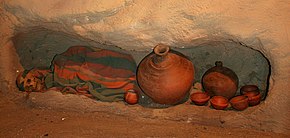
By the early 4th century, if not before, theKingdom of Kushwith its capitalMeroewas collapsing.[10]The region which would later constitute Makuria, i.e. the Nile Valley between the thirdNile cataractand the great Nile bend of the fourth/fifth cataract, has been proposed to have seceded from Kush already in the 3rd century. Here, a homogenous and relatively isolated culture dubbed as "pre-Makuria" developed.[11]During the 4th and 5th centuries, the region ofNapata,located near the fourth cataract and formerly being one of the most important political and sacred places of Kush, served as the center for a new regional elite buried in largetumulilike those atel ZumaorTanqasi.[12]There was a significant population growth[13]accompanied by social transformations,[14]resulting in the absorption of the Kushites into theNubians,[15]a people originally from Kordofan[16]that had settled in the Nile Valley in the 4th century AD.[17]Thus, a new Makurian society and state emerged[14]by the 5th century.[18]In the late 5th century one of the first Makurian kings[19]moved the power base of the still-developing kingdom from Napata to further downstream, where the fortress of Dongola, the new seat of the royal court, was founded[20]and which soon developed a vast urban district.[21]Many more fortresses were built along the banks of the Nile, probably not intended to serve a military purpose, but to foster urbanization.[19]
Already at the time of the foundation of Dongola contacts were maintained with theByzantine Empire.[22]In the 530s, the Byzantines under EmperorJustinianmounted a policy of expansion. The Nubians were part of his plan to win allies against theSasanian Persiansby converting them to Christianity, the Byzantine state religion. The imperial court, however, was divided in two sects, believing in two different natures ofJesus Christ:Justinian belonged to theChalcedonians,theofficial denomination of the empire,while his wifeTheodorawas aMiaphysite,who were the strongest inEgypt.John of Ephesusdescribed how two competing missions were sent to Nubia, with the Miaphysite arriving first in, and converting, the northern kingdom of Nobatia in 543. While the Nobatian king refused Justinian's mission to travel further south[23]archaeological records might suggest that Makuria converted still in the first half of the 6th century.[24]The chroniclerJohn of Biclarrecorded that in around 568 Makuria had “received the faith of Christ”. In 573 a Makurian delegation arrived in Constantinople, offeringivoryand agiraffeand declaring its good relationship with the Byzantines. Unlike Nobatia in the north (with which Makuria seemed to have been in enmity)[25]and Alodia in the south Makuria embraced the Chalcedonian doctrine.[26]The early ecclesiastical architecture at Dongola confirms the close relations maintained with the empire,[25]trade between the two states was flourishing.[27]

In the 7th century, Makuria annexed its northern neighbour Nobatia. While there are several contradicting theories,[a]it seems likely that this occurred soon after the Sasanian occupation of Egypt,[29]presumably during the 620s,[30]but before 642.[31]Before the Sasanian invasion, Nobatia used to have strong ties with Egypt[30]and was thus hit hard by its fall.[32]Perhaps it was also invaded by the Sasanians itself: some local churches from that period show traces of destruction and subsequent rebuilding.[33]Thus weakened, Nobatia fell to Makuria, making Makuria extend as far north asPhilaenear the first cataract.[34]A new bishopric was founded in Faras in around 630[b]and two new cathedrals styled after the basilica of Dongola were built in Faras and Qasr Ibrim.[30]It is not known what happened to the royal Nobatian family after the unification,[36]but it is recorded that Nobatia remained a separate entity within the unified kingdom governed by anEparch.[37]

Between 639 and 641 the Muslim Arabs overranByzantine Egypt.A Byzantine request for help remained unanswered by the Nubians due to conflicts with theBeja.In 641 or 642 the Arabs sent a first expedition into Makuria.[38]While it is not clear how far south[c]it penetrated it was eventually defeated. A second invasion led by Abdallah abi Sarh followed in 651/652, when the attackers pushed as far south as Dongola.[40]Dongolawas besiegedand bombarded bycatapults.While they damaged parts of the town they could not penetrate the walls of the citadel.[41]Muslim sources highlight the skill of the Nubianarchersin repelling the invasion.[42]With both sides being unable to decide the battle in their favour, abi Sarh and the Makurian kingQaliduruteventually met and drew up a treaty known asBaqt.[43]Initially it was a ceasefire also containing an annual exchange of goods (Makurian slaves for Egyptianwheat,textiles etc.),[44]an exchange typical for historical North East African states and perhaps being a continuation of terms already existing between the Nubians and Byzantines.[45]Probably inUmayyadtimes the treaty was expanded by regulating the safety of Nubians in Egypt and Muslims in Makuria.[46]While some modern scholars view the Baqt as a submission of Makuria to the Muslims it is clear that it was not: the exchanged goods were of equal value and Makuria was recognized as an independent state,[47]being one of the few to beat back the Arabs during theearly Islamic expansion.[48]The Baqt would remain in force for more than six centuries,[49]although at times interrupted by mutual raids.[50]
The 8th century was a period of consolidation. Under kingMerkurios,who lived in the late 7th and early 8th century and whom the Coptic biographJohn the Deaconapprovingly refers to as “the newConstantine”,the state seems to have been reorganized and Miaphysite Christianity to have become the official creed.[51]He probably also founded the monumentalGhazali monastery(around 5000 m2) inWadi Abu Dom.[52]Zacharias, Merkurios' son and successor, renounced his claim to the throne and went into a monastery, but maintained the right to proclaim a successor. Within a few years there were three different kings[53]and several Muslim raids[50]until before 747, the throne was seized byKyriakos.[54]In that year, John the Deacon claims, the Umayyad governor of Egypt imprisoned the Coptic Patriarch, resulting in a Makurian invasion and siege of Fustat, the Egyptian capital, after which the Patriarch was released.[54]This episode has been referred to as “Christian Egyptian propaganda”,[55]although it is still likely that Upper Egypt was subject to a Makurian campaign,[54]perhaps a raid.[56]Nubian influence in Upper Egypt would remain strong.[57]Three years later, in 750, the sons ofMarwan II,the last Umayyad Caliph, fled to Nubia and asked Kyriakos for asylum, although without success.[58]In around 760 Makuria was probably visited by theChinesetravellerDu Huan.[59]
Zenith (9th–11th century)[edit]

The kingdom was at its peak between the 9th and 11th centuries.[62]During the reign of king Ioannes in the early 9th century, relations with Egypt were cut and the Baqt ceased to be paid. Upon Ioannes' death in 835 anAbbasidemissary arrived, demanding the Makurian payment of the missing 14 annual payments and threatening with war if the demands are not met.[63]Thus confronted with a demand for more than 5000 slaves,[50]Zakharias III "Augustus",the new king, had his sonGeorgios Icrowned king, probably to increase his prestige, and sent him to the caliph inBaghdadto negotiate.[d]His travel drew much attention at the time.[65]The 12th centurySyriac PatriarchMichaeldescribed Georgios and his retinue in some detail, writing that Georgios rode a camel, wielded a sceptre and a golden cross in his hands and that a red umbrella was carried over his head. He was accompanied by a bishop, horsemen and slaves, and to his left and right were young men wielding crosses.[66]A few months after Georgios arrived in Baghdad he, described as educated and well-mannered, managed to convince the caliph of remitting the Nubian debts and reducing the Baqt payments to a 3-year rhythm.[67]In 836[68]or early 837[69]he had returned to Nubia. After his return a new church was built in Dongola, the Cruciform Church, which had an approximate height of 28m and came to be the largest building in the entire kingdom.[70]A new palace, the so-calledThrone Hall of Dongola,was also built,[71]showing strong Byzantine influences.[72]
In 831 a punitive campaign of the Abbasid Caliphal-Mutasimdefeated theBejaeast of Nubia. As a result, they had to submit to the Caliph, thus expanding nominal Muslim authority over much of the SudaneseEastern Desert.[73]In 834 al-Mutasim ordered that the Egyptian Arab Bedouins, who had been declining as a military force since the rise of the Abbasids, were not to receive any more payments. Discontented and dispossessed, they pushed southwards. The road into Nubia was, however, blocked by Makuria: while there existed communities of Arab settlers in Lower Nubia the great mass of the Arab nomads was forced to settle among the Beja,[74]driven also by the motivation to exploit the local gold mines.[75]In the mid-9th century the Arab adventurer al-Umari hired a private army and settled at a mine nearAbu Hamadin eastern Makuria. After a confrontation between both parties, al-Umari occupied Makurian territories along the Nile.[76]King Georgios I sent an elite force[77]commanded by his son in law, Nyuti,[78]but he failed to defeat the Arabs and rebelled against the crown himself. King Georgios then sent his oldest son, presumably the laterGeorgios II,but he was abandoned by his army and was forced to flee to Alodia. The Makurian king then sent another son, Zacharias, who worked together with al-Umari to kill Nyuti before eventually defeating al-Umari himself and pushing him into the desert.[77]Afterward, al-Umari attempted to establish himself in Lower Nubia, but was soon pushed out again before finally being murdered during the reign of theTulunidSultanAhmad ibn Tulun(868-884).[79]

During the rule of theIkhshididdynasty, relations between Makuria and Egypt worsened: in 951 a Makurian army marched against Egypt'sKharga Oasis,killing and enslaving many people.[80]Five years later the Makurians attacked Aswan, but were subsequently chased as far south as Qasr Ibrim. A new Makurian attack on Aswan followed immediately, which was answered by another Egyptian retaliation, this time capturing Qasr Ibrim.[81]This did not put a hold on Makurian aggression and between 962–964 they again attacked, this time pushing as far north asAkhmim.[82]Parts of Upper Egypt apparently remained occupied by Makuria for several years.[83][84]Ikhshidid Egypt eventually fell in 969, when it was conquered by theShiiteFatimids.Immediately afterward they sent the emissaryIbn Selim el-Aswanito the Makurian king Georgios III.[85]Georgios accepted the first request of the emissary, the resumption of the Baqt, but declined the second one, the conversion to Islam, after a lengthy discussion with his bishops and learned men and instead invited the Fatimid governor to embrace Christianity. Afterwards, he granted al-Aswani to celebrateEid al-Adhaoutside of Dongola with drums and trumpets, though not without the discontent of some of his subjects.[86]Relations between Makuria and Fatimid Egypt were to remain peaceful, as the Fatimids needed the Nubians as allies against theirSunnienemies.[85]

The kingdom of Makuria was, at least temporarily, exercising influence over the Nubian-speaking populations ofKordofan,the region between the Nile Valley andDarfur,as is suggested by an account of the 10th century travellerIbn Hawqalas well as oral traditions.[89]With the southern Nubian kingdom of Alodia, with which Makuria shared its border somewhere between Abu Hamad and the Nile-Atbaraconfluence,[90]Makuria seemed to have maintained a dynastic union, as according to the accounts of Arab geographers from the 10th century[91]and Nubian sources from the 12th century.[92]Archaeological evidence shows an increased Makurian influence on Alodian art and architecture from the 8th century.[93]Meanwhile, evidence for contact with Christian Ethiopia is surprisingly scarce.[94][95]An exceptional case[96]was the mediation of Georgios III between PatriarchPhilotheosand some Ethiopian monarch,[97]perhaps the lateAksumiteemperor Anbessa Wudem or his successor Dil Ne’ad.[98]Ethiopian monks travelled through Nubia to reachJerusalem,[99]a graffito from the church of Sonqi Tino testifies its visit by an Ethiopianabuna.[100]Such travellers also transmitted knowledge of Nubian architecture, which influenced several medieval Ethiopian churches.[61]

During the second half of the 11th century, Makuria saw great cultural and religious reforms, referred to as "Nubization". The main initiator has been suggested to have been Georgios, the archbishop of Dongola and hence the head of the Makurian church.[101]He seems to have popularized the Nubian language as written language to counter the growing influence of Arabic in the Coptic Church[102]and introduced the cult of dead rulers and bishops as well as indigenous Nubian saints. A new, unique church was built inBanganarti,probably becoming one of the most important ones in the entire kingdom.[103]In the same period Makuria also began to adopt a new royal dress[104]and regalia and perhaps also Nubian terminology in administration and titles, all suggested to have initially come from Alodia in the south.[102][105]
Decline (12th century–1365)[edit]
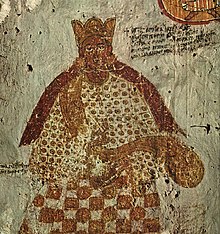

In 1171Saladinoverthrew the Fatimid dynasty, which signaled new hostilities between Egypt and Nubia.[84]The following year,[106]a Makurian army pillaged Aswan and advanced even further north. It is not clear if this campaign was intended to aid the Fatimids or was merely a raid[84]exploiting the unstable situation in Egypt,[107]although the latter seems more likely, as the Makurians apparently soon withdrew.[108]To deal with the Nubians, Saladin sent his brotherTuran-Shah.The latter conquered Qasr Ibrim in January 1173,[109]reportedly sacking it, taking many prisoners, pillaging the church and converting it into a mosque.[110]Afterward, he sent an emissary to the Makurian king, Moses Georgios,[111]intending to answer a previously requested peace treaty with a pair of arrows.[112]Probably ruling over both Makuria and Alodia,[92]Moses Georgios was a man confident in his ability to resist the Egyptians, stamping with hot iron a cross on the emissary's hand.[111]Turan Shah withdrew from Nubia but left a detachment of Kurdish troops in Qasr Ibrim, which would raid Lower Nubia for the next two years. Archaeological evidence links them with the destruction of the cathedral of Faras,[113]Abdallah Nirqi[114]and Debeira West.[citation needed]In 1175 a Nubian army finally arrived to confront the invaders at Adindan. Before battle, however, the Kurdish commander drowned while crossing the Nile, resulting in the retreat of Saladin's troops out of Nubia.[113]Afterwards there was peace for another 100 years.[84]
There are no records from travelers to Makuria from 1172 to 1268,[115]and the events of this period have long been a mystery, although modern discoveries have shed some light on this era. During this period Makuria seems to have entered a steep decline. The best source on this isIbn Khaldun,writing in the 14th century, who blamed it onBedouininvasions similar to what the Mamluks were dealing with. Other factors for the decline of Nubia might have been the change of African trade routes[116]and a severe dry period between 1150 and 1500.[117]

Matters would change with the rise of theMamluksand SultanBaybarsin 1260.[118]In 1265 a Mamluk army allegedly raided Makuria as far south as Dongola[119]while also expanding southwards along the African Red Sea coast, thus threatening the Nubians.[120]In 1272 kingDavidmarched east and attacked the port town ofAidhab,[121]located on an importantpilgrimageroute toMecca.The Nubian army destroyed the town, causing “a blow to the very heart of Islam”.[122]A punitive Mamluk expedition was sent in response, but did not pass beyond the second cataract.[123]Three years later the Makurians attacked and destroyed Aswan,[121]but this time Mamluk Sultan Baybars responded with a well-equipped army setting off from Cairo in early 1276,[122]accompanied by a cousin of king David named Mashkouda[124]or Shekanda.[125]The Mamluks defeated the Nubians in three battles at Gebel Adda, Meinarti and finally at theBattle of Dongola.David fled upstream the Nile, eventually enteringal-Abwabin the south,[126]which, previously being Alodia's northernmost province, had by this period become a kingdom of its own.[127]The king of al-Abwab, however, handed David over to Baybars, who had him executed.[128]
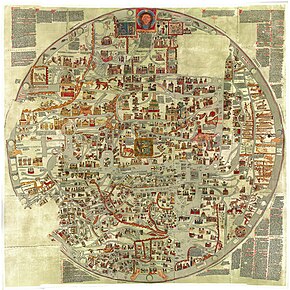
Thanks to thecrusades,[133]western Europe grew increasingly aware of the existence of Christian Nubia during the 12th and 13th centuries until in the early 14th century, there were even proposals to ally with the Nubians for another crusade against the Mamluks.[134]Nubian characters also start to be featured incrusader songs,first displayed as Muslims and later, after the 12th century and with increasing knowledge of Nubia, as Christians.[135]Contacts between crusaders and western pilgrims on the one side and Nubians on the other occurred in Jerusalem,[133]where European accounts from the 12th–14th centuries attest the existence of a Nubian community,[136]and also, if not primarily in Egypt, where many Nubians were living[137]and where European merchants were highly active.[138]Perhaps there also existed a Nubian community incrusader-controlledFamagusta,Cyprus.[139]In the mid-14th century pilgrimNiccolò da Poggibonsiclaimed that the Nubians had sympathies for theLatinsand hence the Mamluk Sultan did not allow Latins to travel to Nubia as he was afraid that they might convince the Nubians to start a war,[140]although in the contemporaryBook of Knowledge of All Kingdomsit was written thatGenoesetraders were present in Dongola.[141]A text was found in Qasr Ibrim apparently mixing Nubian withItalian[142]as well as aCatalan playing card[143]and in Banganarti there has been noted an inscription written inProvencaldating to the second half of the 13th century/14th century.[144]
Internal difficulties seem to have also hurt the kingdom. King David's cousin Shekanda claimed the throne and traveled to Cairo to seek the support of the Mamluks. They agreed and took over Nubia in 1276, and placed Shekanda on the throne. The Christian Shekanda then signed an agreement making Makuria a vassal of Egypt, and a Mamluk garrison was stationed in Dongola. A few years later, Shamamun, another member of the Makurian royal family, led a rebellion against Shekanda to restore Makurian independence. He eventually defeated the Mamluk garrison and took the throne in 1286 after separating from Egypt and betraying the peace deal. He offered the Egyptians an increase in the annual Baqt payments in return for scrapping the obligations to which Shekanda had agreed. The Mamluk armies were occupied elsewhere, and the Sultan of Egypt agreed to this new arrangement.[citation needed]


After a period of peace, King Karanbas defaulted on these payments, and the Mamluks again occupied the kingdom in 1312. This time, a Muslim member of the Makurian dynasty was placed on the throne. Sayf al-Din Abdullah Barshambu began converting the nation to Islam and in 1317 the throne hall of Dongola was turned into amosque.This was not accepted by other Makurian leaders and the nation fell into civil war and anarchy later that year. Barshambu was eventually killed and succeeded byKanz ad-Dawla.While ruling, his tribe, the Banu Khanz, acted a puppet dynasty of the Mamluks.[145]King Karanbas tried to wrestle control from Kanz ad-Dwala in 1323 and eventually seized Dongola, but was ousted just one year later. He retreated to Aswan for another chance to seize the throne, but it never came.[146]
The ascension of the Muslim king Abdallah Barshambu and his transformation of the throne hall into a mosque has often been interpreted as the end of Christian Makuria. This conclusion is erroneous, since Christianity evidently remained vital in Nubia.[147]While not much is known about the following decades, it seems that there were both Muslim and Christian kings on the Makurian throne. Both the travellerIbn Battutaand the Egyptian historianShihab al-Umariclaim that the contemporary Makurian kings were Muslims belonging to the Banu Khanz, while the general population remained Christian. Al-Umari also points out that Makuria was still dependent on the Mamluk Sultan.[148]On the other hand, he also remarks that the Makurian throne was seized in turns by Muslims and Christians.[149]Indeed, an Ethiopian monk who travelled through Nubia in around 1330, Gadla Ewostatewos, states that the Nubian king, who he claims to have met in person, was Christian.[150]In theBook of Knowledge of All Kingdoms,which relies on an anonymous traveller from the mid-14th century, it is claimed that the "Kingdom of Dongola" was inhabited by Christians and that its royal banner was a cross on white background (see flag).[141]Epigraphical evidence reveals the names of three Makurian kings:Siti (king)and Abdallah Kanz ad-Dawla, both ruling during the 1330s, andPaper (king),who is dated to the mid 14th century.[151]The attestations of Siti's reign, all Nubian in nature, show that he still exercised control/influence over a vast territory from Lower Nubia to Kordofan,[152]suggesting that his kingdom entered the second half of the 14th century centralized, powerful and Christian.[153]
It was also in the mid 14th century, more particularly after 1347, when Nubia would have been devastated by theplague.Archaeology confirms a rapid decline of the Christian Nubian civilization since then. Due to their small population the plague might have cleansed entire landscapes from its Nubian inhabitants.[154]

In 1365, there occurred yet another short, but disastrous civil war. The current king was killed in battle by his rebelling nephew, who had allied himself with the Banu Ja'd tribe. The brother of the deceased king and his retinue fled to a town calledDawin the Arabic sources, most likely identical withGebel Addain Lower Nubia.[155]The usurper then killed the nobility of the Banu Ja'd, probably because he could not trust them anymore, and destroyed and pillaged Dongola, then traveled to Gebel Adda to ask his uncle for forgiveness. Thus Dongola was left to the Banu Ja'd and Gebel Adda became the new capital.[156]
Terminal period (1365–late 15th century)[edit]
The Makurian rump state[edit]
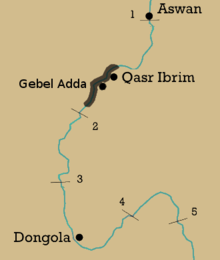
Both the usurper and the rightful heir, and most likely even the king that was killed during the usurpation, were Christian.[157]Now residing in Gebel Adda, the Makurian kings continued their Christian traditions.[158]They ruled over a reduced rump state with a confirmed north–south extension of around 100 km, albeit it might have been larger in reality.[159]Located in a strategically irrelevant periphery, the Mamluks left the kingdom alone.[158]In the sources this kingdom appears asDotawo.Until recently it was commonly assumed thatDotawowas, before the Makurian court shifted its seat to Gebel Adda, just a vasal kingdom of Makuria, but it is now accepted that it was merely theOld Nubianself-designation for Makuria.[160]
The last known king isJoel,who is mentioned in a 1463 document and in an inscription from 1484. Perhaps it was under Joel when the kingdom witnessed a last, brief renaissance.[161]After the death or deposition of king Joel the kingdom might have collapsed.[162]The cathedral of Faras came out of use after the 15th century, just as Qasr Ibrim was abandoned by the late 15th century.[127]The palace of Gebel Adda came out of use after the 15th century as well.[159]In 1518, there is one last mention of a Nubian ruler, albeit it is unknown where he resided and if he was Christian or Muslim.[163]However, in 2023 Adam Simmons pointed to the existence in the 1520s of Christian Nubian Queen Gaua.[164]There were no traces of an independent Christian kingdom when the Ottomans occupiedLower Nubiain the 1560s,[162]while theFunjhad come into possession of Upper Nubia south of the third cataract.
Further developments[edit]
Political[edit]
By the early 15th century, there is mention of a king of Dongola, most likely independent from the influence of the Egyptian sultans.Friday prayersheld in Dongola failed to mention them as well.[165]These new kings of Dongola were probably confronted with waves of Arab migrations and thus were too weak to conquer the Makurian splinter state of Lower Nubia.[166]
It is possible that some petty kingdoms that continued the Christian Nubian culture developed in the former Makurian territory, for example on Mograt island, north ofAbu Hamed.[167]Another small kingdom was the Kingdom of Kokka, probably founded in the 17th century in the no-mans-land between the Ottoman Empire in the north and the Funj in the south. Its organization and rituals bore clear similarities to those of Christian times.[168]Eventually the kings themselves were Christians until the 18th century.[169]
In 1412, theAwlad Kenztook control of Nubia and part of Egypt above theThebaid.
Ethnographic and linguistic[edit]

The NubiansupstreamofAl Dabbahstarted to assume an Arabic identity and the Arabic language, eventually becoming theJa'alin,claimed descendants ofAbbas,uncle ofMuhammad.[170]The Ja'alin were already mentioned byDavid Reubeni,who travelled through Nubia in the early 16th century.[171]They are now divided into several sub-tribes, which are, from Al Dabbah to the conjunction of the Blue and White Nile:Shaiqiya,Rubatab,Manasir,Mirafab and the "Ja'alin proper".[172]Among them, Nubian remained a spoken language until the 19th century.[171]North of the Al Dabbah developed three Nubian sub-groups: The Kenzi, who, before the completion of theAswan Dam,lived between Aswan andMaharraqa,the Mahasi, who settled between Maharraqa andKermaand theDanagla,the southernmost of the remaining Nile Valley Nubians. Some count the Danagla to the Ja'alin, since the Danagla also claim to belong to that Arab tribe, but they in fact still speak a Nubian language,Dongolawi.[173]North Kordofan,which was still a part of Makuria as late as the 1330s,[174]also underwent a linguisticArabizationsimilar to the Nile Valley upstream of Al Dabbah. Historical and linguistic evidence confirms that the locals were predominantly Nubian-speaking until the 19th century, with a language closely related to the Nile-Nubian dialects.[175]
Today, the Nubian language is in the process of being replaced by Arabic.[176]Furthermore, the Nubians have increasingly started to claim to be Arabs descending from Abbas, disregarding their Christian Nubian past.[177]
Culture[edit]
Christian Nubia was historicaly considered to be something of a backwater, because their graves were small and lacking thegrave goodsof previous eras.[178]Modern scholars understand that this was due to cultural differences, and that the Makurians actually had rich and vibrant arts and culture.
Languages[edit]

Four languages were used in Makuria:Nubian,Coptic,GreekandArabic.[179]Nubian was represented by two dialects, with Nobiin being said to have been spoken in the Nobadia province in the north andDongolawiin the Makurian heartland,[180]although in the Islamic period Nobiin is also attested to have been employed by theShaigiya tribein the southeasternDongola Reach.[181] The royal court employed Nobiin despite being located in Dongolawi-speaking territory. By the eight century Nobiin had been codified based on the Coptic alphabet,[182]but it was not until the 11th century when Nobiin had established itself as language of administrative, economic and religious documents.[183]The rise of Nobiin overlapped with the decline of the Coptic language in both Makuria and Egypt.[184]It has been suggested that before the rise of Nobiin as a literary language, Coptic served as official administrative language, but this seems doubtful; Coptic literary remains are virtually absent in the Makurian heartland.[185]In Nobadia, however, Coptic was fairly widespread,[186]probably even serving as alingua franca.[184]Coptic also served as the language of communication with Egypt and the Coptic Church. Coptic refugees escaping Islamic persecution settled in Makuria, while Nubian priests and bishops would have studied in Egyptian monasteries.[187]Greek, the third language, was of great prestige and used in religious context, but does not seem to have been actually spoken (similar toLatinin medieval Europe).[188] Lastly, Arabic was used from the 11th and 12th centuries, superseding Coptic as language of commerce and diplomatic correspondences with Egypt. Furthermore, Arab traders and settlers were present in northern Nubia,[189]although the spoken language of the latter appears to have gradually shifted from Arabic to Nubian.[190]
Arts[edit]
Wallpaintings[edit]
As of 2019, around 650 murals distributed over 25 sites have been recorded,[191]with more paintings still awaiting publication.[192]One of the most important discoveries of the rushed work prior to the flooding of Lower Nubia was the Cathedral ofFaras.This large building had been completely filled with sand preserving a series of paintings. Similar, but less well preserved, paintings have been found at several other sites in Makuria, including palaces and private homes, giving an impression of Makurian art. The style and content was heavily influenced byByzantine art,and also showed influence from Egyptian Coptic art and from Palestine.[193]Mainly religious in nature, it depicts many of the standardChristian scenes.Also illustrated are a number of Makurian kings and bishops, with noticeably darker skin than theBiblical figures.
- Gallery
-
Christ, Abu Oda (second half of the 7th century)
-
Saint Peterinserted into a Pharaonic painting,Wadi es-Sebua(late 7th-early 8th century)
-
St. Anne,Faras (8th-first half of the 9th century)
-
Apostle Saints Peter and John (8th-first half of the 10th century)
-
Warrior saint with spear and shield, Faras (9th century)
-
Archangel Gabrielwith sword, Faras (9th-first quarter of the 10th century)
-
Madonna and Christ Child, Faras (10th century)
-
Three youths in the furnace,Faras (last quarter of the 10th century)
-
Theophany and bishop, Abdallah Nirqi (late 10th-early 11th century)
-
Magi on horseback, Faras (late 10th–early 11th century
-
Bishop Marianos withMadonnaandChrist Child,Faras (first half of the 11th century)
-
Elaborate cross, Faras (11th century)
-
Nubian dignitary and Christ, Faras (12th century)
-
Baptism of Christ,Old Dongola (12th–13th century)
-
Warrior saint, Meinarti (late 13th-mid 14th century)
Manuscript illustrations[edit]
-
Old Nubian manuscript from Serra East (973) showing some richly robed individual
-
Detail of a manuscript from Serra East showing a sitting man
-
Old Nubian manuscript from Qasr Ibrim showing a bishop
-
St. Menasand boatman on an Old Nubian manuscript found in Edfu
Pottery[edit]

Shinnie refers to Nubian pottery as the "richest indigenous pottery tradition on the African continent." Scholars divide the pottery into three eras.[194]The early period, from 550 to 650 according to Adams, or to 750 according to Shinnie, saw fairly simple pottery similar to that of the lateRoman Empire.It also saw much of Nubian pottery imported from Egypt rather than produced domestically. Adams feels this trade ended with the invasion of 652; Shinnie links it to the collapse ofUmayyadrule in 750. After this domestic production increased, with a major production facility atFaras.In this middle era, which lasted until around 1100, the pottery was painted with floral and zoomorphic scenes and showed distinct Umayyad and evenSassanianinfluences.[195]The late period during Makuria's decline saw domestic production again fall in favour of imports from Egypt. Pottery produced in Makuria became less ornate, but better control of firing temperatures allowed different colours of clay.
Role of women[edit]

The Christian Nubian society wasmatrilineal[196]and women enjoyed a high social standing.[197]The matrilineal succession gave the queen mother and the sister of the current king as forthcoming queen mother great political relevance.[196]This importance is attested by the fact that she constantly appears in legal documents.[198]Another female political title was theasta( "daughter" ), perhaps some type of provincial representative.[197]
Women had access to education[197]and there is evidence that, like in Byzantine Egypt, female scribes existed.[199]Private land tenure was open to both men and women, meaning that both could own, buy and sell land. Transfers of land from mother to daughter were common.[200]They could also be the patrons of churches and wall paintings.[201]Inscriptions from the cathedral of Faras indicate that around every second wall painting had a female sponsor.[202]An inscription from Faras suggests that women could also serve asdeacons.[203]
Hygiene[edit]
Latrines were a common sight in Nubian domestic buildings.[204]In Dongola all houses had ceramic toilets.[205]Some houses in Cerra Matto (Serra East) featured privies with ceramic toilets, which were connected to a small chamber with a stone-lined clean out window to the outside and a brick ventilation flue.[206]Biconical pieces of clay served as the equivalent of toilet paper.[207]
One house in Dongola featured a vaulted bathroom, fed by a system of pipes attached to a water tank.[208]A furnace heated up both the water and the air, which was circulated into the richly decorated bathroom via flues in the walls.[68]The monastic complex of Hambukol is thought to have had a room serving as a steam bath.[208]The Ghazali monastery in Wadi Abu Dom also might have featured several bathrooms.[209]
Government[edit]

Makuria was a monarchy ruled by a king based in Dongola. The king was also considered a priest and could performmass.Howsuccessionwas decided is not clear. Early writers indicate it was from father to son. After the 11th century, however, it seems clear that Makuria was using the uncle-to-sister's-son system favoured for millennia inKush.Shinnie speculates that the later form may have actually been used throughout, and that the early Arab writers merely misunderstood the situation and incorrectly described Makurian succession as similar to what they were used to.[210]A Coptic source from the mid 8th century refers to king Cyriacos as "orthodox Abyssinian king of Makuria" as well as "Greek king", with "Abyssinian" probably reflecting the Miaphysite Coptic church and "Greek" the Byzantine Orthodox one.[211]In 1186 king Moses Georgios called himself "king of Alodia, Makuria, Nobadia, Dalmatia[g]and Axioma. "[213]
Little is known about government below the king. A wide array of officials, generally using Byzantine titles, are mentioned, but their roles are never explained. One figure who is well-known, thanks to the documents found atQasr Ibrim,is theEparchofNobatia,who seems to have been the viceroy in that region after it was annexed to Makuria. The Eparch's records make clear that he was also responsible for trade and diplomacy with the Egyptians. Early records make it seem like the Eparch was appointed by the king, but later ones indicate that the position had become hereditary.[214]The elite of Makuria was drawn from noblemen who the Islamic sources called "princes". It was them who constituted the courtiers, military commanders and bishops. They were apparently powerful enough to openly exlaim their discontent and even depose the ruler if they were unhappy with him, despite claims in Islamic sources that the power of the Makurian king was absolute.[215]A selected few of them, the elders, constituted a council that assisted the king in his decision making. The elders aside it was also the queenmother who bore a key role in advising the king. In 1292 an unnamed Makurian king is even reported to have claimed that "it was only the women who direct the kings [...]"[216]
Thebishopsmight have played a role in the governance of the state.Ibn Selim el-Aswaninoted that before the king responded to his mission he met with a council of bishops.[217]El-Aswani described a highly centralized state, but other writers state that Makuria was a federation of thirteen kingdoms presided over by the great king at Dongola.[218]
Kings[edit]
Religion[edit]
Paganism[edit]

One of the most debated issues among scholars is over the religion of Makuria. Up to the 5th century the old faith ofMeroeseems to have remained strong, even whileancient Egyptian religion,its counterpart in Egypt, disappeared. In the 5th century the Nubians went so far as to launch an invasion of Egypt when the Christians there tried to turn some of the main temples into churches.[219]A portion of the Nubian population seemingly remained pagan as late as the 10th century, for el-Aswani reported that "[s]ome of them do not know the Creator and adore the Sun and the Day; some others adore whatever they like; trees or animals."[220]
Christianity[edit]
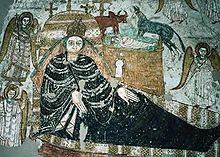

Archaeological evidence in this period finds a number of Christian ornaments in Nubia, and some scholars feel that this implies that conversion from below was already taking place. Others argue that it is more likely that these reflected the faith of the manufacturers in Egypt rather than the buyers in Nubia.
Certain conversion came with a series of 6th-century missions. TheByzantine Empiredispatched an official party to try to convert the kingdoms toChalcedonianChristianity, butEmpress Theodorareportedly conspired to delay the party to allow a group ofMiaphysitesto arrive first.[221]John of Ephesusreports that the Monophysites successfully converted the kingdoms ofNobatiaandAlodia,but that Makuria remained hostile.John of Biclarumstates that Makuria then embraced the rival Byzantine Christianity. Archaeological evidence seems to point to a rapid conversion brought about by an official adoption of the new faith. Millennia-old traditions such as the building of elaborate tombs, and the burying of expensive grave goods with the dead were abandoned, and temples throughout the region seem to have been converted to churches. Churches eventually were built in virtually every town and village.[194]
After this point the exact course of Makurian Christianity is much disputed. It is clear that by c. 710 Makuria had become officiallyCopticand loyal to theCoptic Patriarch of Alexandria;[222]the king of Makuria became the defender of the patriarch of Alexandria, occasionally intervening militarily to protect him, asKyriakosdid in 722. This same period saw Melkite Makuria absorb the Coptic Nobatia, historians have long wondered why the conquering state adopted the religion of its rival. It is fairly clear that Egyptian Coptic influence was far stronger in the region, and that Byzantine power was fading, and this might have played a role. Historians are also divided on whether this was the end of the Melkite/Coptic split as there is some evidence that a Melkite minority persisted until the end of the kingdom.
Church infrastructure[edit]
The Makurian church was divided into seven bishoprics:Kalabsha,Qupta,Qasr Ibrim,Faras,Sai,Dongola,and Suenkur.[223]UnlikeEthiopia,it appears that no national church was established and all seven bishops reported directly to theCoptic Patriarch of Alexandria.The bishops were appointed by the Patriarch, not the king, though they seem to have largely been local Nubians rather than Egyptians.[224]
Monasticism[edit]

Unlike in Egypt, there is not much evidence formonasticismin Makuria. According to Adams there are only three archaeological sites that are certainly monastic. All three are fairly small and quite Coptic, leading to the possibility that they were set up by Egyptian refugees rather than indigenous Makurians.[225]Since the 10th/11th century the Nubians had their own monastery in the EgyptianWadi El Natrunvalley.[226]
Islam[edit]

The Baqt guaranteed the security of Muslims travelling in Makuria,[227]but prohibited their settlement in the kingdom. However, the latter point was, not maintained:[228]Muslim migrants, probably merchants and artisans,[229]are confirmed to have settled in Lower Nubia from the 9th century and to have intermarried with the locals, thus laying the foundation for a small Muslim population[230]as far south as theBatn el-Hajar.[231]Arabic documents from Qasr Ibrim confirm that these Muslims had their own communal judiciary,[232]but still regarded the Eparch of Nobatia as their suzerain.[233]It seems likely that they had own mosques, though none have been identified archaeologically,[229]with a possible exception being in Gebel Adda.[228]
In Dongola, there was no larger number of Muslims until the end of the 13th century. Before that date, Muslim residents were limited to merchants and diplomats.[234]In the late 10th century, when al-Aswani came to Dongola, there was, despite being demanded in the Baqt, still no mosque; he and around 60 other Muslims had to pray outside of the city.[235]It is not until 1317, with the conversion of the throne hall by Abdallah Barshambu, when a mosque is firmly attested.[236]While theJizya,the Islamic head tax enforced on non-Muslims, was established after the Mamluk invasion of 1276[237]and Makuria was periodically governed by Muslim kings since Abdallah Barshambu, the majority of the Nubians remained Christian.[238]The actual Islamization of Nubia began in the late 14th century, with the arrival of the first in a series of Muslim teachers propagating Islam.[239]
Economy[edit]

The main economic activity in Makuria was agriculture, with farmers growing several crops a year ofbarley,millet,anddates.The methods used were generally the same that had been used for millennia. Small plots of well irrigated land were lined along the banks of the Nile, which would be fertilized by the river's annual flooding. One important technological advance was thesaqiya,anoxen-poweredwater wheel,that was introduced in the Roman period and helped increase yields and population density.[240]Settlement patterns indicate that land was divided into individual plots rather than as in a manorial system. The peasants lived in small villages composed of clustered houses ofsun-dried brick.

Important industries included the production ofpottery,based atFaras,andweavingbased atDongola.Smaller local industries includeleatherworking,metalworking, and the widespread production ofbaskets,mats,andsandalsfrom palm fibre.[241]Also important was the gold mined in theRed Sea Hillsto the east of Makuria.[194]
Cattlewere of great economic importance. It is possible that their breeding and marketing was controlled by the central administration. A great assemblage of 13th century cattle bones from Old Dongola has been linked with a mass slaughter by the invading Mamluks, who attempted to weaken the Makurian economy.[242]

Makurian trade was largely by barter as the state never adopted acurrency,though Egyptian coins were common in the north.[1]Makurian trade with Egypt was of great importance. From Egypt a wide array of luxury and manufactured goods were imported. The main Makurian export was slaves. The slaves sent north were not from Makuria itself, but rather from further south and west in Africa. Little is known about Makurian trade and relations with other parts of Africa. There is some archaeological evidence of contacts and trade with the areas to the west, especiallyKordofan.Additionally, contacts toDarfurandKanem-Bornuseem probable, but there are only few evidences. There seem to have been important political relations between Makuria and ChristianEthiopiato the south-east. For instance, in the 10th century,Georgios IIsuccessfully intervened on behalf of the unnamed ruler at that time, and persuadedPatriarch Philotheos of Alexandriato at last ordain anabuna,ormetropolitan,for theEthiopian Orthodox Church.However, there is little evidence of much other interaction between the two Christian states.[citation needed]
See also[edit]
Annotations[edit]
- ^Theory I places that event at the time of the Sasanian invasion, theory II at the time between the first and second Arab invasion, i.e. 642 and 652, and the third at the turn of the seventh century.[28]
- ^It has also been argued that the bishopric was not founded, but merely reestablished.[35]
- ^Recently it has been suggested that the Arabs fought the Nubians not in Nubia, but in Upper Egypt, which remained a battle zone contested by both parties until the Arab conquest of Aswan in 652.[39]
- ^Zakharias, presumably already quite powerful during the lifetime of Ioannes, was the husband of a sister of Ioannes. The matrilinear Nubian succession demanded that only the son of the king's sister could be the next king, hence making Zakharias an illegitimate king in contrast to his son Georgios.[64]
- ^The claim of complete nakedness should not be taken for a fact, as it reflects an ancient stereotype.[131]
- ^This might be a reference to the original three kingdoms of Nobatia, Makuria and Alodia, unless the author was implying the semi-autonomous status of Nobatia within Makuria.[131]
- ^"Dalmatia" or "Damaltia" is probably an error forTolmeita(ancient Ptolemais in Libya), which was a part of the patriarch of Alexandria's title: "archbishop of the great city of Alexandria and the city of Babylon (Cairo), and Nobadia, Alodia, Makuria, Dalmatia and Axioma (Axum)." It has been proposed that there was some confusion in the 1186 document between the titles of the king and the patriarch.[212]
Notes[edit]
- ^Murray, John (1822)."Kingdom of Makuria".Dorota Dzierzbicka.22(22): 663–677.
- ^Welsby 2002,p. 239.
- ^Shinnie 1965,p. 266.
- ^Adams 1977,p. 257.
- ^Bowersock, Brown & Grabar 2000,p. 614.
- ^Godlewski 1991,pp. 253–256.
- ^abWyzgol & El-Tayeb 2018,p. 287.
- ^Wyzgol & El-Tayeb 2018,Fig. 10.
- ^Kołosowska & El-Tayeb 2007,p. 35.
- ^Edwards 2004,p. 182.
- ^Lohwasser 2013,pp. 279–285.
- ^Godlewski 2014,pp. 161–162.
- ^Werner 2013,p. 42.
- ^abGodlewski 2014,p. 161.
- ^Werner 2013,p. 39.
- ^Werner 2013,pp. 32–33.
- ^Rilly 2008,pp. 214–217.
- ^Godlewski 2013b,p. 5.
- ^abGodlewski 2013b,p. 7.
- ^Godlewski 2013b,p. 17.
- ^Godlewski 2014,p. 10.
- ^Werner 2013,p. 43.
- ^Welsby 2002,pp. 31–33.
- ^Werner 2013,p. 58.
- ^abWelsby 2002,p. 33.
- ^Werner 2013,pp. 58, 62–65.
- ^Wyzgol 2018,p. 785.
- ^Werner 2013,pp. 73–74.
- ^Werner 2013,pp. 73–77.
- ^abcGodlewski 2013b,p. 90.
- ^Werner 2013,p. 77.
- ^Godlewski 2013b,p. 85.
- ^Werner 2013,pp. 76, note 84.
- ^Godlewski 2013c,p. 90.
- ^Werner 2013,pp. 77–78.
- ^Welsby 2002,p. 88.
- ^Werner 2013,p. 254.
- ^Welsby 2002,pp. 48–49.
- ^Bruning 2018,pp. 94–96.
- ^Werner 2013,pp. 66–67.
- ^Godlewski 2013a,p. 91.
- ^Welsby 2002,p. 69.
- ^Werner 2013,p. 68.
- ^Werner 2013,pp. 70–72.
- ^Ruffini 2012,pp. 7–8.
- ^Werner 2013,pp. 73, 71.
- ^Ruffini 2012,p. 7.
- ^Welsby 2002,p. 68.
- ^Werner 2013,p. 70.
- ^abcWelsby 2002,p. 73.
- ^Werner 2013,p. 82.
- ^Obłuski 2019,p. 310.
- ^Werner 2013,p. 83.
- ^abcWerner 2013,p. 84.
- ^Adams 1977,p. 454.
- ^Hasan 1967,p. 29.
- ^Shinnie 1971,p. 45.
- ^Werner 2013,p. 86, note 37.
- ^Smidt 2005,p. 128.
- ^Godlewski 2013b,pp. 11, 39.
- ^abFritsch 2018,pp. 290–291.
- ^Godlewski 2002,p. 75.
- ^Werner 2013,p. 88.
- ^Godlewski 2002,pp. 76–77.
- ^Werner 2013,p. 89.
- ^Vantini 1975,p. 318.
- ^Werner 2013,pp. 89–91.
- ^abGodlewski 2013a,p. 11.
- ^Werner 2013,p. 91.
- ^Godlewski 2013b,p. 11.
- ^Obłuski et al. 2013,Table 1.
- ^Godlewski 2013b,p. 12.
- ^Adams 1977,pp. 553–554.
- ^Adams 1977,pp. 552–553.
- ^Godlewski 2002,p. 84.
- ^Werner 2013,pp. 94–95, note 50.
- ^abGodlewski 2002,p. 85.
- ^Werner 2013,p. 95.
- ^Werner 2013,p. 96.
- ^Hasan 1967,p. 91.
- ^Werner 2013,pp. 99–100, notes 16 and 17.
- ^Werner 2013,p. 101.
- ^Lobban, Richard A. (2003-12-09).Historical Dictionary of Ancient and Medieval Nubia.Scarecrow Press.ISBN978-0-8108-6578-5.
- ^abcdAdams 1977,p. 456.
- ^abWerner 2013,p. 102.
- ^Hasan 1967,p. 92.
- ^Lepage & Mercier 2005,pp. 120–121.
- ^Chojnacki 2005,p. 184.
- ^Hesse 2002,pp. 18, 23.
- ^Welsby 2014,pp. 187–188.
- ^Welsby 2002,p. 89.
- ^abLajtar 2009,pp. 93–94.
- ^Danys & Zielinska 2017,pp. 182–184.
- ^Lajtar & Ochala 2017,p. 264.
- ^Welsby 2002,pp. 214–215.
- ^Hendrickx 2018,p. 1, note 1.
- ^Werner 2013,p. 103.
- ^Hendrickx 2018,p. 17.
- ^Obłuski 2019,p. 126.
- ^Lajtar & Ochala 2017,pp. 262–264.
- ^Godlewski 2013a,pp. 671, 672.
- ^abGodlewski 2013a,p. 669.
- ^Godlewski 2013a,pp. 672–674.
- ^Wozniak 2014,pp. 939–940.
- ^Wozniak 2014,p. 940.
- ^Welsby 2002,p. 75.
- ^Plumley 1983,p. 162.
- ^Ruffini 2012,pp. 249–250.
- ^Werner 2013,p. 113.
- ^Plumley 1983,pp. 162–163.
- ^abRuffini 2012,p. 248.
- ^Welsby 2002,p. 76.
- ^abPlumley 1983,p. 164.
- ^Welsby 2002,p. 124.
- ^Adams 1977,p. 522.
- ^Grajetzki 2009,pp. 121–122.
- ^Zurawski 2014,p. 84.
- ^Werner 2013,p. 117.
- ^Werner 2013,p. 117, note 16.
- ^Gazda 2005,p. 93.
- ^abWerner 2013,p. 118.
- ^abGazda 2005,p. 95.
- ^Seignobos 2016,p. 554.
- ^Seignobos 2016,p. 554, note 2.
- ^Welsby 2002,p. 244.
- ^Werner 2013,pp. 120–122.
- ^abWelsby 2002,p. 254.
- ^Werner 2013,pp. 122–123.
- ^von den Brincken 2014,pp. 45, 49–50.
- ^von den Brincken 2014,p. 48.
- ^abSeignobos 2014,p. 1000.
- ^Seignobos 2014,pp. 999–1000.
- ^abŁajtar & Płóciennik 2011,p. 110.
- ^Seignobos 2012,pp. 307–311.
- ^Simmons 2019,pp. 35–46.
- ^Werner 2013,p. 128.
- ^Łajtar & Płóciennik 2011,p. 111.
- ^Łajtar & Płóciennik 2011,pp. 114–116.
- ^Borowski 2019,pp. 103–106.
- ^Werner 2013,p. 133.
- ^abWerner 2013,pp. 134–135.
- ^Ruffini 2012,pp. 162–263.
- ^Borowski 2019,p. 106.
- ^Łajtar & Płóciennik 2011,p. 43.
- ^O'Fahey & Spaulding 1974,p. 17.
- ^Welsby 2002,p. 248.
- ^Werner 2013,p. 138.
- ^Werner 2013,pp. 139–140, note 25.
- ^Zurawski 2014,p. 82.
- ^Werner 2013,p. 140.
- ^Werner 2013,pp. 140–141.
- ^Ochala 2011,pp. 154–155.
- ^Ruffini 2012,pp. 253–254.
- ^Werner 2013,pp. 141–143.
- ^Welsby 2002,pp. 248–250.
- ^Werner 2013,pp. 143–144.
- ^Werner 2013,p. 144.
- ^abWelsby 2002,p. 253.
- ^abWerner 2013,p. 145.
- ^Ruffini 2012,p. 9.
- ^Lajtar 2011,pp. 130–131.
- ^abRuffini 2012,p. 256.
- ^Werner 2013,p. 149.
- ^Adam Simmons, 'A Short Note on Queen Gaua: A New Last Known Ruler of Dotawo (r. around 1520-6)?',Dotawo: A Journal of Nubian Studies(2023),doi:10.5070/D60060625.
- ^Zurawski 2014,p. 85.
- ^Adams 1977,p. 536.
- ^Werner 2013,p. 150.
- ^Werner 2013,pp. 148, 157, note 68.
- ^Welsby 2002,p. 256.
- ^Adams 1977,pp. 557–558.
- ^abO'Fahey & Spaulding 1974,p. 29.
- ^Adams 1977,p. 562.
- ^Adams 1977,pp. 559–560.
- ^Ochala 2011,p. 154.
- ^Hesse 2002,p. 21.
- ^Werner 2013,p. 188, note 26.
- ^Werner 2013,p. 26, note 44.
- ^Adams 1977,p. 495.
- ^Welsby 2002,pp. 236–239.
- ^Werner 2013,p. 186.
- ^Bechhaus-Gerst 1996,pp. 25–26.
- ^Werner 2013,p. 187.
- ^Ochala 2014,p. 36.
- ^abOchala 2014,p. 41.
- ^Ochala 2014,pp. 36–37.
- ^Ochala 2014,p. 37.
- ^Werner 2013,pp. 193–194.
- ^Ochala 2014,pp. 43–44.
- ^Werner 2013,p. 196.
- ^Seignobos 2010,p. 14.
- ^Zielinska & Tsakos 2019,p. 80.
- ^Zielinska & Tsakos 2019,p. 93.
- ^Godlewski 1991,pp. 255–256.
- ^abcShinnie 1965,p.?.
- ^Shinnie 1978,p. 570.
- ^abWerner 2013,p. 248.
- ^abcWerner 2013,p. 344.
- ^Ruffini 2012,p. 243.
- ^Ruffini 2012,pp. 237–238.
- ^Ruffini 2012,pp. 236–237.
- ^Werner 2013,pp. 344–345.
- ^Ruffini 2012,p. 235.
- ^Ochała 2023,pp. 361–363.
- ^Welsby 2002,pp. 170–171.
- ^Godlewski 2013a,p. 97.
- ^Williams et al. 2015,p. 135.
- ^Welsby 2002,pp. 171–172.
- ^abWelsby 2002,p. 172.
- ^Obłuski 2017,p. 373.
- ^Shinnie 1978,p. 581.
- ^Greisiger 2007,p. 204.
- ^Hagen 2009,p. 117.
- ^Werner 2013,p. 243.
- ^Adams 1991,p. 258.
- ^Lajtar & Ochala 2021,pp. 371–372, 374–375.
- ^Lajtar & Ochala 2021,pp. 375–376.
- ^Jakobielski 1992,p. 211.
- ^Zabkar 1963,p.?.
- ^Adams 1977,p. 440.
- ^Vantini 1975,p. 616.
- ^Adams 1977,p. 441.
- ^"Information on Medieval Nubia".Archived fromthe originalon 2018-01-03.Retrieved2013-03-11.
- ^Shinnie 1978,p. 583.
- ^Adams 1977,p. 472.
- ^Adams 1977,p. 478.
- ^al-Suriany 2013,p. 257.
- ^Godlewski 2013b,p. 101.
- ^abWelsby 2002,p. 106.
- ^abAdams 1977,p. 468.
- ^Werner 2013,p. 155.
- ^Seignobos 2010,pp. 15–16.
- ^Khan 2013,p. 147.
- ^Welsby 2002,p. 107.
- ^Godlewski 2013a,p. 117.
- ^Holt 2011,p. 16.
- ^Werner 2013,p. 71, note 44.
- ^Werner 2013,pp. 121–122.
- ^Werner 2013,pp. 137–140.
- ^Werner 2013,pp. 155–156.
- ^Shinnie 1978,p. 556.
- ^Jakobielski 1992,p. 207.
- ^Osypinska 2015,p. 269.
References[edit]
- Adams, William Y. (1977).Nubia: Corridor to Africa.Princeton:Princeton University.ISBN978-0-7139-0579-3.
- Adams, William Y. (1991). "The United Kingdom of Makouria and Nobadia: A Medieval Nubian Anomaly". In W.V. Davies (ed.).Egypt and Africa: Nubia from Prehistory to Islam.London: British Museum Press.ISBN978-0-7141-0962-6.
- al-Suriany, Bigoul (2013). "Identification of the Monastery of the Nubians in Wadi al-Natrun". In Gawdat Gabra; Hany N. Takla (eds.).Christianity and Monasticism in Aswan and Nubia.Saint Mark Foundation. pp. 257–264.ISBN978-9774167645.
- Bechhaus-Gerst, Marianne (1996).Sprachwandel durch Sprachkontakt am Beispiel des Nubischen im Niltal(in German). Köppe.ISBN3-927620-26-2.
- Beckingham, C.F.; Huntingford, G.W.B. (1961).The Prester John of the Indies.Cambridge: Hakluyt Society.
- Borowski, Tomasz (2019). "Placed in the Midst of Enemies? Material Evidence for the Existence of Maritime Cultural Networks Connecting Fourteenth-Century Famagusta with Overseas Regions in Europe, Africa and Asia". In Walsh, Michael J. K. (ed.).Famagusta Maritima. Mariners, Merchants, Pilgrims and Mercenaries.Brill. pp. 72–112.ISBN9789004397682.
- Bowersock, G. W.; Brown, Peter; Grabar, Oleg (2000). "Nubian language".A Guide to the Postclassical World.Harvard University Press.
- Bruning, Jelle (2018).The Rise of a Capital: Al-Fusṭāṭ and Its Hinterland, 18-132/639-750.Brill.ISBN978-90-04-36636-7.
- Burns, James McDonald (2007).A History of Sub-Saharan Africa.Cambridge: Cambridge University Press. p. 418.ISBN978-0-521-86746-7.
- Chojnacki, Stanislaw (2005). "Wandgemälde, Ikonen, Manuskripte, Kreuze und anderes liturgisches Gerät". In Walter Raunig (ed.).Das christliche Äthiopien. Geschichte, Architektur, Kunst(in German). Schnell und Steiner. pp. 171–250.ISBN9783795415419.
- Danys, Katarzyna; Zielinska, Dobrochna (2017). "Alwan art. Towards an insight into the aesthetics of the Kingdom of Alwa through the painted pottery decoration".Sudan&Nubia.21:177–185.ISSN1369-5770.
- Edwards, David (2004).The Nubian Past: An Archaeology of the Sudan.Routledge.ISBN978-0415369879.
- Fritsch, Emmanuel (2018). "The Origins and Meanings of the Ethiopian Circular Church". In Robin Griffith-Jones, Eric Fernie (ed.).Tomb and Temple. Re-Imagining the Sacred Buildings of Jerusalem.Boydell. pp. 267–296.ISBN9781783272808.
- Gazda, M (2005). "Mameluke invasions on Nubia in the 13th Century. Some Thoughts on Political Interrelations in the Middle East".Gdansk African Reports.3.Gdansk Archaeological MuseumGdansk Archaeological Museum.ISSN1731-6146.
- Godlewski, Wlodzimierz (1991). "The Birth of Nubian Art: Some Remarks". In W.V. Davies (ed.).Egypt and Africa: Nubia from Prehistory to Islam.London: British Museum.ISBN978-0-7141-0962-6.
- Godlewski, Wlodzimierz (2002). "Introduction to the Golden Age of Makuria".Africana Bulletin.50:75–98.
- Godlewski, Wlodzimierz (2013a)."Archbishop Georgios of Dongola. Socio-political change in the kingdom of Makuria in the second half of the 11th century"(PDF).Polish Archaeology in the Mediterranean.22:663–677.
- Godlewski, Włodzimierz (2013b).Dongola-ancient Tungul. Archaeological guide(PDF).Polish Centre of Mediterranean Archaeology, University of Warsaw.ISBN978-83-903796-6-1.
- Godlewski, Wlodzimierz (2013c). "The Kingdom of Makuria in the 7th century. The struggle for power and survival". In Christian Julien Robin; Jérémie Schiettecatte (eds.).Les préludes de l'Islam. Ruptures et continuités.De Boccard. pp. 85–104.ISBN978-2-7018-0335-7.
- Godlewski, Włodzimierz (2014)."Dongola Capital of early Makuria: Citadel – Rock Tombs – First Churches"(PDF).In Angelika Lohwasser; Pawel Wolf (eds.).Ein Forscherleben zwischen den Welten. Zum 80. Geburtstag von Steffen Wenig.Mitteilungen der Sudanarchäologischen Gesellschaft zu Berlin E.v.ISSN0945-9502.
- Grajetzki, Wolfram (2009)."Das Ende der christlich-nubischen Reiche"(PDF).Internet-Beiträge zur Ägyptologie und Sudanarchäologie.X.
- Greisiger, Lutz (2007)."Ein nubischer Erlöser-König: Kus in syrischen Apokalypsen des 7. Jahrhunderts"(PDF).In Sophia G. Vashalomidze, Lutz Greisiger (ed.).Der christliche Orient und seine Umwelt.
- Hagen, Joost (2009). "Districts, Towns and Other Locations of Medieval Nubia and Egypt, Mentioned in the Coptic and Old Nubian Texts from Qasr Ibrim".Sudan & Nubia.13:114–119.
- Hasan, Yusuf Fadl (1967).The Arabs and the Sudan. From the seventh to the early sixteenth century.Edinburgh University Press.OCLC33206034.
- Hesse, Gerhard (2002).Die Jallaba und die Nuba Nordkordofans. Händler, Soziale Distinktion und Sudanisierung.Lit.ISBN3825858901.
- Hendrickx, Benjamin (2018)."The Letter of an Ethiopian King to King George II of Nubia in the framework of the ecclesiastic correspondence between Axum, Nubia and the Coptic Patriarchate in Egypt and of the events of the 10th Century AD".Pharos Journal of Theology:1–21.ISSN2414-3324.
- Holt, P. A. (2011).A History of the Sudan.Pearson Education.ISBN978-1405874458.
- Jakobielski, S (1992). "Christian Nubia at the Height of its Civilization".UNESCO General History of Africa. Volume III.University of California.ISBN978-0-520-06698-4.
- Khan, Geoffrey (2013)."The Medieval Arabic Documents from Qasr Ibrim".Qasr Ibrim, between Egypt and Africa.Peeters. pp. 145–156.
- Kropacek, L. (1997). "Nubia from the late twelfth century to the Funj conquest in the early fifteenth century".UNESCO General History of Africa. Volume IV.
- Kołosowska, Elżbieta; El-Tayeb, Mahmoud (2007). "Excavations at the Kassinger Bahri Cemetery Sites HP45 and HP47".Gdańsk Archaeological Museum African Reports.5:9–37.
- Lev, Yaacov (1999).Saladin in Egypt.BRILL.ISBN978-90-04-11221-6.
- Łajtar, Adam; Płóciennik, Tomasz (2011). "A man from Provence on the Middle Nile: A graffito in the Upper Church at Banganarti". In Łajtar, Adam; van der Vliet, Jacques (eds.).Nubian Voices. Studies in Christian Nubian Culture.Taubenschlag. pp. 95–120.ISBN978-83-925919-4-8.
- Lajtar, Adam; Ochala, Grzegorz (2017)."An Unexpected Guest in the Church of Sonqi Tino".Dotawo: A Journal of Nubian Studies.4:257–268.doi:10.5070/D64110003.
- Lajtar, Adam; Ochala, Grzegorz (2021)."A Christian King in Africa. The Image of Christian Nubian Rulers in Internal and External Sources".The Good Christian Ruler in the First Millennium.pp. 361–380.
- Lajtar, Adam (2009)."Varia Nubica XII-XIX"(PDF).The Journal of Juristic Papyrology(in German).XXXIX:83–119.ISSN0075-4277.
- Lajtar, Adam (2011)."Qasr Ibrim's last land sale, AD 1463 (EA 90225)".Nubian Voices. Studies in Christian Nubian Culture.
- Lepage, Clade; Mercier, Jacques (2005).Les églises historiques du Tigray. The Ancient Churches of Tigrai.Editions Recherche sur les Civilisations.ISBN2-86538-299-0.
- Lohwasser, Angelika (2013). "Das „Ende von Meroe". Gedanken zur Regionalität von Ereignissen ". In Feder, Frank; Lohwasser, Angelika (eds.).Ägypten und sein Umfeld in der Spätantike. Vom Regierungsantritt Diokletians 284/285 bis zur arabischen Eroberung des Vorderen Orients um 635-646. Akten der Tagung vom 7.-9.7.2011 in Münster.Harrassowitz. pp. 275–290.ISBN9783447068925.
- Martens-Czarnecka, Malgorzata (2015)."The Christian Nubia and the Arabs".Studia Ceranea.5:249–265.doi:10.18778/2084-140X.05.08.hdl:11089/18404.ISSN2084-140X.
- McHugh, Neil (1994).Holymen of the Blue Nile: The Making of an Arab-Islamic Community in the Nilotic Sudan.Northwestern University.ISBN0810110695.
- Michalowski, K. (1990). "The Spreading of Christianity in Nubia".UNESCO General History of Africa.Vol. II. University of California.ISBN978-0-520-06697-7.
- Obłuski, Arthur (2017)."The winter seasons of 2013 and 2014 in the Ghazali monastery".Polish Archaeology in the Mediterranean.26/1.
- Obłuski, Arthur (2019).The Monasteries and Monks of Nubia.The Taubenschlag Foundation.ISBN978-83-946848-6-0.
- Obłuski, Artur; Godlewski, Włodzimierz; Kołątaj, Wojciech; et al. (2013)."The Mosque Building in Old Dongola. Conservation and revitalization project"(PDF).Polish Archaeology in the Mediterranean.22.Polish Centre of Mediterranean Archaeology, University of Warsaw: 248–272.ISSN2083-537X.
- Ochala, Grzegorz (2011). "A King of Makuria in Kordofan". In Adam Lajtar, Jacques van der Vliet (ed.).Nubian Voices. Studies in Christian Nubian Culture.Journal of Juristic Papyrology. pp. 149–156.
- Ochala, Grzegorz (2014)."Multilingualism in Christian Nubia: Qualitative and Quantitative Approaches".Dotawo: A Journal of Nubian Studies.1.Journal of Juristic Papyrology.doi:10.5070/D61110007.ISBN978-0692229149.
- Ochała, Grzegorz (2023). "Female diaconate in medieval Nubia: Evidence from a wall inscription from Faras".Bulletin of the School of Oriental and African Studies.86(2): 351–365.
- O'Fahey, R. S.; Spaulding, Jay (1974).Kingdoms of Sudan.Methuen Young Books.
- Osypinska, Marta (2015). "Animals: archaeozoological research on the osteological material from the Citadel". In Włodzimierz Godlewski; Dorota Dzierzbicka (eds.).Dongola 2012-2014. Fieldwork, conservation and site management.Polish Centre of Mediterranean Archaeology, University of Warsaw. pp. 259–271.ISBN978-83-903796-8-5.
- Plumley, J. Martin (1983). "Qasr Ibrim and Islam".Études et Travaux.XII:157–170.
- Rilly, Claude (2008)."Enemy brothers: Kinship and relationship between Meroites and Nubians (Noba)".Between the Cataracts: Proceedings of the 11th Conference of Nubian Studies, Warsaw, 27 August – 2 September 2006. Part One.PAM. pp. 211–225.ISBN978-83-235-0271-5.
- Ruffini, Giovanni R. (2012).Medieval Nubia. A Social and Economic History.Oxford University.
- Ruffini, Giovanni (2013). "Newer light on the Kingdom of Dotawo". In J. van der Vliet; J. L. Hagen (eds.).Qasr Ibrim, between Egypt and Africa. Studies in Cultural Exchange (NINO Symposium, Leiden, 11–12 December 2009).Peeters. pp. 179–191.ISBN9789042930308.
- Seignobos, Robin (2010)."La frontière entre le bilād al-islām et le bilād al-Nūba: enjeux et ambiguïtés d'une frontière immobile (VIIe-XIIe siècle)".Afriques(in French).doi:10.4000/afriques.800.
- Seignobos, Robin (2012). "The other Ethiopia: Nubia and the crusade (12th-14th century)".Annales d'Éthiopie.27.Table Ronde: 307–311.doi:10.3406/ethio.2012.1470.ISSN0066-2127.
- Seignobos, Robin (2014). "Nubia and Nubians in Medieval Latin Culture. The Evidence of Maps (12th-14th cent.)". In Anderson, Julie R; Welsby, Derek (eds.).The Fourth Cataract and Beyond: Proceedings of the 12th International Conference for Nubian Studies.Peeters Pub. pp. 989–1005.ISBN978-9042930445.
- Seignobos, Robin (2016)."La liste des conquêtes nubiennes de Baybars selon Ibn Šadd ād (1217 – 1285)"(PDF).In A. Łajtar; A. Obłuski; I. Zych (eds.).Aegyptus et Nubia Christiana. The Włodzimierz Godlewski Jubilee Volume on the Occasion of his 70 th Birthday(in French). Polish Centre of Mediterranean Archaeology. pp. 553–577.ISBN9788394228835.
- Shinnie, P.L. (1971). "The Culture of Medieval Nubia and its Impact on Africa". In Yusuf Fadl Hasan (ed.).Sudan in Africa.Khartoum University. pp. 42–50.OCLC248684619.
- Shinnie, P.L. (1996).Ancient Nubia.London: Kegan Paul.ISBN978-0-7103-0517-6.
- Shinnie, P.L. (1978). "Christian Nubia.". In J.D. Fage (ed.).The Cambridge History of Africa. Volume 2.Cambridge:Cambridge University.pp. 556–588.ISBN978-0-521-21592-3.
- Shinnie, P.L. (1965). "New Light on Medieval Nubia".Journal of African History.VI, 3.
- Simmons, Adam (2019). "The Changing Depiction of the Nubian king in Crusader Songs in an Age of Expanding Knowledge". In Benjamin Weber (ed.).Croisades en Africa. Les expeditions occidentales à destination du continent africain, XIIIe-VVIe siècles.Presses universitaires du Midi Méridiennes. pp. 25–.ISBN978-2810705573.
- Smidt, W. (2005). "An 8th century Chinese fragment on the Nubian and Abyssinian kingdoms". In Walter Raunig; Steffen Wenig (eds.).Afrikas Horn.Harrassowitz. pp. 124–136.
- Spaulding, Jay (1995). "Medieval Christian Nubia and the Islamic World: A Reconsideration of the Baqt Treaty".International Journal of African Historical Studies.XXVIII, 3.
- Vantini, Giovanni (1970).The Excavations at Faras.
- Vantini, Giovanni (1975).Oriental Sources concerning Nubia.Heidelberger Akademie der Wissenschaften.OCLC174917032.
- von den Brincken, Anna-Dorothee (2014). "Spuren Nubiens in der abendländischen Universalkartographie im 12. bis 15. Jahrhundert". In Dlugosz, Magdalena (ed.).Vom Troglodytenland ins Reich der Scheherazade. Archäologie, Kunst und Religion zwischen Okzident und Orient(in German). Frank & Timme. pp. 43–52.ISBN9783732901029.
- Welsby, Derek (2002).The Medieval Kingdoms of Nubia. Pagans, Christians and Muslims along the Middle Nile.The British Museum.ISBN0714119474.
- Welsby, Derek (2014). "The Kingdom of Alwa". In Julie R. Anderson; Derek A. Welsby (eds.).The Fourth Cataract and Beyond: Proceedings of the 12th International Conference for Nubian Studies.Peeters Publishers.pp. 183–200.ISBN978-90-429-3044-5.
- Werner, Roland (2013).Das Christentum in Nubien. Geschichte und Gestalt einer afrikanischen Kirche.Lit.
- Williams, Bruce B.; Heidorn, Lisa; Tsakos, Alexander; Then-Obłuska, Joanna (2015)."Oriental Institute Nubian Expedition (OINE)"(PDF).In Gil J. Stein (ed.).The Oriental Institute 2014–2015 Annual Report.Oriental Institute of the University of Chicago. pp. 130–143.ISBN978-1-61491-030-5.
- Wozniak, Magdalena (2014). "Royal Iconography: Contribution to the Sudy of Costume".The Fourth Cataract and Beyond. Proceedings of the 12th International Conference for Nubian Studies.Leuven. pp. 929–941.
- Wyzgol, Maciej; El-Tayeb, Mahmoud (2018)."Early Makuria Research Project. Excavations at Tanqasi: first season in 2018".Polish Archaeology in the Mediterranean.27:273–288.doi:10.5604/01.3001.0013.2004.ISSN1234-5415.
- Wyzgol, Maciej (2018)."A decorated bronze censer from the Cathedral in Old Dongola".Polish Archaeology in the Mediterranean.26/1.Polish Centre of Mediterranean Archaeology: 773–786.doi:10.5604/01.3001.0012.1811.S2CID55185622.
- Zabkar, Louis (1963). "The Eparch of Nobatia as King".Journal of Near Eastern Studies.
- Zielinska, Dobrochna; Tsakos, Alexandros (2019). "Representations of Archangel Michael in Wall Paintings from Medieval Nubia". In Ingvild Sælid Gilhus; Alexandros Tsakos; Marta Camilla Wright (eds.).The Archangel Michael in Africa. History, Cult and Persona.Bloomsbury Academic. pp. 79–94.ISBN9781350084711.
- Zurawski, Bogdan (2014).Kings and Pilgrims. St. Raphael Church II at Banganarti, mid-eleventh to mid-eighteenth century.IKSiO.ISBN978-83-7543-371-5.
Further reading[edit]
- Eger, Jana (2019). "The Land of Tari and Some New Thoughts on Its Location".The Archaeology of Medieval Islamic Frontiers: From the Mediterranean to the Caspian Sea.University Press of Colorado.ISBN978-1607328780.
- Godlweski, Wlodzimierz (2004). "The Rise of Makuria (late 5th-8th cent.)". In Timothy Kendall (ed.).Nubian Studies. 1998. Proceedings of the Ninth International Conference of Nubian Studies, August 20–26.Northeastern University. pp. 52–72.ISBN0976122103.
- Innemée, Karel C. (2016).Monks and bishops in Old Dongola, and what their costumes can tell us.
- Jakobielski, Stefan; et al., eds. (2017).Pachoras, Faras, The wall paintings from the Cathedrals of Aetios, Paulos and Petros.University of Warsaw.ISBN978-83-942288-7-3.
- Martens-Czarnecka, Małgorzata (2011).The Wall Paintings from the Monastery on Kom H in Dongola.Warsaw University Press.ISBN978-83-235-0923-3.
- Seignobos, Robin (2015)."Les évêches Nubiens: Nouveaux témoinages. La source de la liste de Vansleb et deux autres textes méconnus".In Adam Lajtar; Grzegorz Ochala; Jacques van der Vliet (eds.).Nubian Voices II. New Texts and Studies on Christian Nubian Culture(in French). Raphael Taubenschlag Foundation.ISBN978-8393842575.
- Seignobos, Robin (2016)."La liste des conquêtes nubiennes de Baybars selon Ibn Šadd ād (1217 – 1285)"(PDF).In A. Łajtar; A. Obłuski; I. Zych (eds.).Aegyptus et Nubia Christiana. The Włodzimierz Godlewski Jubilee Volume on the Occasion of his 70 th Birthday(in French). Polish Centre of Mediterranean Archaeology. pp. 553–577.ISBN9788394228835.
- Then-Obłuska, Joanna (2017)."Royal ornaments of a late antique African kingdom, Early Makuria, Nubia (AD 450–550). Early Makuria Research Project".Polish Archaeology in the Mediterranean.26/1:687–718.
- Baadj, Amar (2014). "The Political Context of the Egyptian Gold Crisis during the Reign of Saladin".The International Journal of African Historical Studies.47(1): 121–138.ISSN0361-7882.JSTOR24393332.
- Wozniak, Magdalena.L'influence byzantine dans l'art nubien.
- Wozniak, Magdalena.Rayonnement de Byzance: Le costume royal en Nubie (Xe s.).
- Wozniak, Magdalena (2016).The chronology of the eastern chapels in the Upper Church at Banganarti. Some observations on the genesis of "apse portraits" in Nubian royal iconography.


